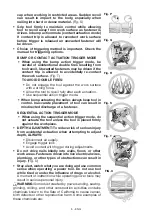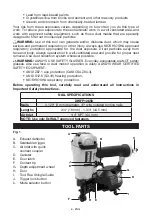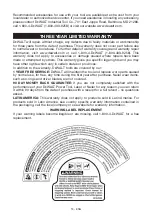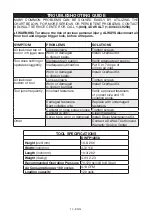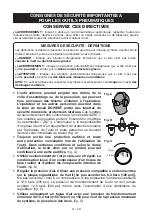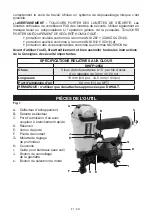
6 - ENG
• Lead from lead-based paints
• Crystalline silica from bricks and cement and other masonry products
• Arsenic and chromium from chemically-treated lumber.
Your risk from these exposures varies, depending on how often you do this type of
work. To reduce your exposure to these chemicals: work in a well ventilated area, and
work with approved safety equipment, such as those dust masks that are specially
designed to filter out microscopic particles.
WARNING: Use of this tool can generate and/or disburse dust, which may cause
serious and permanent respiratory or other injury. Always use NIOSH/OSHA approved
respiratory protection appropriate for the dust exposure. Direct particles away from
face and body. Always operate tool in well-ventilated area and provide for proper dust
removal. Use dust collection system wherever possible.
WARNING: ALWAYS USE SAFETY GLASSES. Everyday eyeglasses are NOT safety
glasses. Also use face or dust mask if operation is dusty. ALWAYS WEAR CERTIFIED
SAFETY EQUIPMENT:
• ANSI Z87.1 eye protection (CAN/CSA Z94.3),
• ANSI S12.6 (S3.19) hearing protection,
• NIOSH/OSHA respiratory protection.
Before operating this tool, carefully read and understand all instructions in
Important Safety Instructions.
NAIL SPECIFICATIONS
DWFP12658
Nails
0.120" (3 mm) diameter, 15º wire collated roofing nails
Lengths
3/4" (19 mm) - 1-3/4" (44.5 mm)
Air Inlet
1/4" NPT (6.4 mm)
NOTE: Use only D
e
WALT approved fasteners
TOOL PARTS
Fig. 1
A. Exhaust deflector
B. Selectable trigger
C. Air Inlet with quick
connect coupler
D. Canister
E. Door latch
F. Contact tip
G. Depth adjustment wheel
H. Door
I.
Tool-Free Shingle Guide
J. Trigger lock button
k. Mode selector button
A
F
J
K
G
C
B
D
I
E
H





